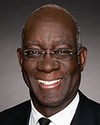I will provide the answer in writing, of course, as far as I can. As I said, I'm not personally involved there. However, I have been instrumental in designing our three conference halls in Heidelberg, with a total of 60 interpreting console places.
I'll now answer Mr. Beaulieu's question.
Yes, there are much better platforms in some respects. We've seen the factors, the parameters measured, and platforms such as Interprefy and Kudo are much better in some of these parameters. The problem is that none of these platforms comes close to a conference interpreting system, and all of them do not match the frequency range that is required to be able to listen and to speak at the same time.
It's very different, as you've probably noticed, if you just listen to a conversation, and even conference interpreters when listening to the speaker and not working themselves sometimes wonder why their colleague is struggling. As soon as you start working yourself, you notice how bad the sound quality is, which you haven't noticed before.
We absolutely need a frequency range from nine to 15 kilohertz—or better, 18 kilohertz.




